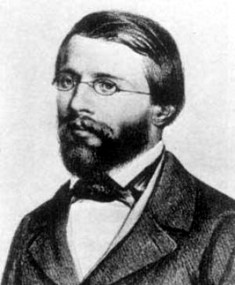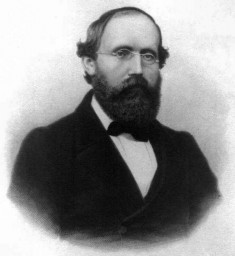The name of Bernhard Riemann is well-known to mathematicians and physicists around the world. This influential German mathematician contributed challenging new ideas and concepts to mathematics. His fundamental contributions to mathematics include number theory, differential equations, real and complex analysis, differential geometry and more.
Early Years
Bernhard Riemann was born in Breselenz in the Kingdom of Hanover in 1826. His father, Friedrich Riemann, was a pastor, and his mother, Charlotte Eden, died when he was just a child. He was a shy boy and young man when he was around people. His father was his first teacher and he began his first arithmetic lessons at the age of six.
Inspired by his father, Bernhard often read the Bible, but his interest in mathematics took over all other activities. Beginning in 1840, he attended the Gymnasium in Hanover, where he lived with his grandmother. In 1842, when his grandmother died, he moved to the Gymnasium at Luneburg.
The University Years
At the age of 19, Bernhard entered the University of Gottingen, where he studied philosophy and theology. However, seeing his interest in mathematics, his teacher, Carl Friedrich Gauss, encouraged him to talk to his parents about switching to a mathematics degree rather than theology. After his father agreed to that, he was transferred to the University of Berlin in 1847.
In 1849, Riemann followed his father’s wishes and came back to the University of Gottingen where he began to attend seminars on mathematical physics. In 1857, after the death of Guass (who was the appointed professor of physics at the University of Gottingen), Riemann was appointed extraordinary professor at the university. During that time, he published his paper on the theory of Abelian functions.
Contributions to Mathematics
 Bernhard lived a relatively short life, but he made great contributions during his lifetime. Although he published only a few papers, his name is attached to a variety of topics in several branches of mathematics, such as Riemannian geometry, the Cauchy-Riemann equation, Riemann surfaces, the Riemannian geometry and Riemann Hypothesis.
Bernhard lived a relatively short life, but he made great contributions during his lifetime. Although he published only a few papers, his name is attached to a variety of topics in several branches of mathematics, such as Riemannian geometry, the Cauchy-Riemann equation, Riemann surfaces, the Riemannian geometry and Riemann Hypothesis.
Riemann’s paper on number theory, entitled On the Number of Primes under a Given Magnitude is the most influential paper ever written in this field. This paper, which was published in 1859, marked the beginning of analytic number theory where arithmetical objects are studied by analytical means.
Bernhard had an extraordinary command over complex analyses which he interconnected with topology and number theory. His other accomplishments in the field of mathematics include differential geometry, tensor analysis, theory of functions and the theory of manifolds.
Many theorems are named after him including the Riemann Roch theorem. Several principles of modern physics are based on Riemann’s notions of the geometry of space. He introduced the Laurent series expansion for functions having poles and branch points. Some of his results and work were rigorously established by Hadamard and Vallee-Poussin in 1896, but the Riemann hypothesis remains unproved.
Riemannian Geometry
In 1854, Riemann presented his thoughts on geometry, for the post-doctoral qualification, to faculty member Gauss at Gottingen who was highly impressed by his ideas. Riemann argued that fundamental ingredients of geometry include space of points and it involves measuring distances along lines or curves in that space.
As per Riemann, the space does not need to be simple Euclidean space, but it could have many dimensions, even infinite dimensions. He also argued that it is not necessary that a surface be drawn completely in three-dimensional space.
His work inspired Eugenio Beltrami, an Italian mathematician, to produce a description of non-Euclidean geometry. Riemann’s idea laid the mathematical foundation for four-dimensional geometry of space-time produced by Einstein in his theory of relativity. Albert Einstein‘s theory of relativity was based on Riemann’s notions of geometry of space.
Publications
Some of his famous writings (which were published after his death) include On the Hypothesis Which Lie at the Foundation of Geometry in 1868, Collected Works of Bernhard Riemann published in 1892, and Collected Papers published in 2004.
Personal Life
In 1862, Bernhard married Elise Koch and had a daughter. From 1863 to 1865, he worked as a professor at the University of Pisa. He died of tuberculosis on July 20, 1866, in Selasca. He was 39 years old at the time.
